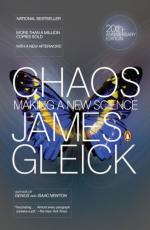
|
| Name: _________________________ | Period: ___________________ |
This test consists of 15 multiple choice questions and 5 short answer questions.
Multiple Choice Questions
1. In his paper, Kuhn argues that rival paradigms are ______, meaning that it is not possible to understand one paradigm through the conceptual framework and terminology of another rival paradigm.
(a) Indistinguishable.
(b) Incomprehensible.
(c) Incommensurable.
(d) Incorrigible.
2. Who does Gleick quote as saying "It does not say in the Bible that all laws of nature are expressible linearily!" in Chapter 3, "Life's Ups and Downs"?
(a) Stanislaw Ulam.
(b) James Yorke.
(c) Wallace Stevens.
(d) Enrico Fermi.
3. What was the name of Edward Lorenz's 1963 paper in Journal of the Atmospheric Sciences?
(a) "Fractals Everywhere".
(b) "The Structure of Scientific Revolutions".
(c) "Deterministic Nonperiodic Flow".
(d) "Physical Review Letters".
4. In Chapter 1, "The Butterfly Effect," the author writes, "The Butterfly Effect acquired a technical name: sensitive dependence on _____________"?
(a) "Random conditions."
(b) "Initial conditions."
(c) "Controlled conditions."
(d) "Ideal conditions."
5. What was the profession of Benoit Mandelbrot's mother?
(a) Writer.
(b) Dentist.
(c) Nurse.
(d) Housekeeper.
6. In Chapter 4, "A Geometry of Nature," Houthakker explained to Mandelbrot the diagram in his office represented eight years of what?
(a) Corn prices.
(b) Cotton prices.
(c) Wheat prices.
(d) Almond prices.
7. What does Gleick assert was the inspiration for Archimedes in Chapter 2, "Revolution"?
(a) A boulder.
(b) A bathtub.
(c) A tree.
(d) A snail.
8. What is the interdisciplinary scientific study of the atmosphere?
(a) Thermodynamics.
(b) Meteorology.
(c) Physiology.
(d) Fractal compression.
9. What is a description of a system using mathematical concepts and language?
(a) Computer model.
(b) Fraction model.
(c) Mathematical model.
(d) Algorithm model.
10. Who is attributed to the following quote from Chapter 2, "Revolution": "Of course, the entire effort is to put oneself outside the ordinary range of what are called statistics"?
(a) James Gleick.
(b) Thomas S. Kuhn.
(c) Stephen Spender.
(d) Richard Feynman.
11. What concept originated by Thomas S. Kuhn refers to the routine work of scientists experimenting within a paradigm, slowly accumulating detail in accord with established broad theory and not actually challenging or attempting to test the underlying assumptions of that theory?
(a) Bland science.
(b) Normal science.
(c) Science of commonality.
(d) Psuedoscience.
12. When was James Yorke born?
(a) 1932.
(b) 1949.
(c) 1941.
(d) 1937.
13. What refers to a computer program or network of computers that attempts to simulate an abstract model of a particular system?
(a) Computer virus.
(b) Computer model.
(c) Computer army.
(d) Computer hardware.
14. Where is the main laboratory for the Thomas J. Watson Research Center?
(a) Yorktown Heights, New York.
(b) Chicago, Illinois.
(c) Indianapolis, Indiana.
(d) Cherry Hill, New Jersey.
15. In what year did Edward Lorenz create a weather simulator as described in Chapter 1, "The Butterfly Effect"?
(a) 1966.
(b) 1948.
(c) 1951.
(d) 1960.
Short Answer Questions
1. In Chapter 2, "Revolution," Gleick writes that the only problem with studying and experimenting with a new science is what?
2. Where is Stephen Smale from?
3. What studies the behavior of dynamical systems that are highly sensitive to initial conditions?
4. Who is quoted in Chapter 1, "The Butterfly Effect" as saying "Physicists like to think that all you have to do is say, these are the conditions, now what happens next?"
5. Where is the European Center for Medium Range Forecasts headquartered?
|
This section contains 511 words (approx. 2 pages at 300 words per page) |

|




